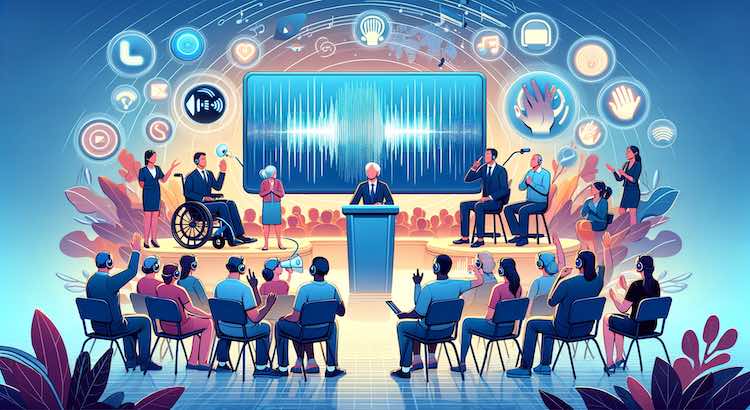The Role of Automated Transcription in Accessibility for the Deaf and Hard of Hearing
Access to information matters for everyone. For people who are deaf or hard of hearing, audio and video content can be a barrier. Automated transcription services break down this barrier by changing spoken words into readable text. This guide explains how automated transcription helps to create a more accessible world, while highlighting its benefits and challenges.
Why Accessibility Matters
- About 15% of American adults report some trouble hearing (CDC, 2023).
- Digital content is growing, but not all formats are easy to access for everyone.
- Making content accessible helps businesses and organizations reach wider audiences.
Key Benefits of Automated Transcription for Deaf and Hard of Hearing People
- Transforms spoken words from videos, meetings, podcasts, and live events into clear text.
- Fulfills legal requirements, such as the Americans with Disabilities Act (ADA).
- Supports learning and participation at work, in school, and in daily life.
How Automated Transcription Bridges Communication Gaps
Automated transcription technology uses speech recognition and artificial intelligence to turn audio into text in real time. This allows people who are deaf or hard of hearing to:
- Access the same information as others.
- Follow conversations in group settings, meetings, or online events.
- Gain independence by reading instead of listening.
Real-World Examples
- Live captions during webinars or conferences.
- [Closed caption services](https://gotranscript.com/closed-captioning-services) for video content on social media and education sites.
- [Transcription services](https://gotranscript.com/transcription-services) for podcasts and interviews.
Automated Transcription and Education
Learning often depends on listening. Automated transcription lets all students fully join in class discussions, lectures, and video lessons. The use of accurate captions:
- Improves understanding and note-taking.
- Boosts grades and engagement for students with hearing loss (NCES, 2022).
- Supports ESL learners who benefit from reading along as they listen.
Services like [subtitling services](https://gotranscript.com/subtitling-services) make it easier for everyone to follow along.
Making Classrooms Inclusive
- Teachers can upload class recordings for [automated transcription](https://gotranscript.com/automated-transcription-services).
- Schools can offer [AI transcription subscriptions](https://gotranscript.com/ai-transcription-subscription) for ongoing support.
Workplace Contributions of Automated Transcription
Meetings, training sessions, and remote teamwork all create large amounts of spoken information. For deaf and hard of hearing employees, transcription ensures they can:
- Read meeting transcripts and stay up to date.
- Engage fully in team discussions and decision making.
- Review and reference past conversations quickly.
This kind of support not only meets legal standards but also builds diverse, inclusive workplaces.
Standing Out as an Inclusive Employer
- Offer [transcription proofreading services](https://gotranscript.com/transcription-proofreading-services) for key meetings.
- Let employees easily [order transcription](https://gotranscript.com/upload/transcriptions) of calls or webinars.
Boosting Public Access and Participation
Automated transcription helps people stay informed about the world around them. For public events, city meetings, and news broadcasts, providing transcripts:
- Enables everyone to follow local and national news.
- Promotes civic engagement and equal rights.
- Expands the audience for media, making content available in multiple languages with [audio translation services](https://gotranscript.com/audio-translation-services) and [text translation services](https://gotranscript.com/text-translation-services).
How Automated Transcription Technology Works
Modern automated transcription relies on artificial intelligence and machine learning. Advances since 2020 have led to faster, more accurate systems (Gartner, 2022). Key features include:
- Speech recognition with support for many languages and accents.
- AI that improves with more use and feedback.
- Quick processing — often delivering transcripts within minutes.
Continuous innovation keeps making transcription better and more affordable. You can compare [transcription pricing](https://gotranscript.com/cheap-transcription-rates) and [captioning services pricing](https://gotranscript.com/cheap-captioning-rates) to find options that fit your needs.
Common Challenges and Considerations
While automated transcription offers many advantages, a few challenges still exist:
- Accuracy drops with strong accents, background noise, or technical language.
- Not all platforms support real-time captioning.
- Some events need human editors to proofread important transcripts.
Even with these challenges, most automated transcription services regularly improve. Feedback from users helps companies fix errors and train AI to recognize more words and phrases.
How to Choose the Right Service
- Check for language support and ability to handle accents or jargon.
- Look for options that include human proofreading when needed.
- Make sure the platform meets privacy and security standards.
Conclusion: Automated Transcription Makes a Difference
Automated transcription services are key to creating a truly accessible digital world. They help people who are deaf or hard of hearing in schools, workplaces, and public life. As technology gets smarter, accessibility and inclusion will only improve.
If you want to make your content open to everyone, GoTranscript offers professional transcription, captioning, and translation solutions. Explore services like automated transcription or closed caption services to see how easy it is to add accessible features to your audio and video content. Make sure everyone can join the conversation—choose the right tools for accessibility today.



















 Verified Order
Verified Order